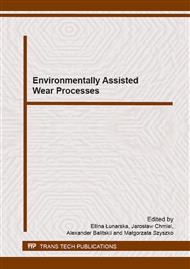[1]
A.J. Schwartz, Automated Crystal Lattice Orientation Mapping Using a Computer-controlled SEM, Micron, Vol. 28, (1997) 249-265.
DOI: 10.1016/s0968-4328(97)00010-3
Google Scholar
[2]
A.J. Schwartz, M. Kumar, B.L. Adams, D.P. Field, Electron Backscatter Diffraction in Materials Science, (2009), Springer.
Google Scholar
[3]
K. Sztwiertnia, M. Faryna, G. Sawina, , Quantitative Misorientation Characteristics in Interphase Boundaries in Composites", Journal of Microscopy, (2006), Vol. 224, 4-7.
DOI: 10.1111/j.1365-2818.2006.01636.x
Google Scholar
[4]
K. Berent, M. Faryna, M. Płońska, Orientation mapping applied to the study of ferroelectric ceramic, Materials Science and Engineering 7, (2010), 1-7.
DOI: 10.1088/1757-899x/7/1/012003
Google Scholar
[5]
S. Deevi, V. Sikka, Nickel and iron aluminides: an overview on properties, processing, and applications, Intermetallics 4, (1996), 357-375.
DOI: 10.1016/0966-9795(95)00056-9
Google Scholar
[6]
C.T. Liu, V.K. Sikka, Metals and Materials Society, Journal of the Minerals, (1986), 38.
Google Scholar
[7]
J. Bystrzycki, R. Varin, Z. Bojar, Postępy w badaniach stopów na bazie uporządkowanych faz międzymetalicznych z udziałem aluminium, Inżynieria Materiałowa 5, (1996), 137-149.
Google Scholar
[8]
P. Jóźwik, Z. Bojar, D. Zasada, Influence of heat treatment on structure and mechanical properties of Ni3Al (Zr, B) intermetallic alloy, Inżynieria Materiałowa Nr 3-4, (2007), 169-174.
Google Scholar
[9]
P. Jóźwik, Z. Bojar, Analysis of grain size effect on tensile properties of Ni3Al - based intermetallic strips, Archives of Metallurgy and Materials, Vol. 52, (2007), 321-327.
Google Scholar
[10]
P. Jóźwik, Z. Bojar, Influence of heat treatment on the structure and mechanical properties of Ni3Al - based alloys, Archives of Metallurgy and Materials, Vol. 55, (2010), 271-279.
Google Scholar
[11]
P. Jóźwik, M. Karcz, J. Badur, Numerical modelling of a microreactor for thermocatalytic decomposition of toxic compounds, Chemical and Process Engineering, Vol. 32, (2011), 215-227.
DOI: 10.2478/v10176-011-0017-3
Google Scholar
[12]
P. Jóźwik, Z. Bojar, P. Kołodziejczak, Microjoining of Ni3Al based intermetallic thin foil, Materials Science and Technology, Vol. 26, (2010), 473-477.
DOI: 10.1179/026708309x12468927349334
Google Scholar
[13]
M. Kamaya, A.J. Wilkinson, J.M. Titchmarsh, Measurement of plastic strain of polycrystalline material by electron backscatter diffraction, Nuclear Engineering and Design 235, (2005), 713–725.
DOI: 10.1016/j.nucengdes.2004.11.006
Google Scholar
[14]
D. Zasada, Z. Zarański, R. Jasionowski, The influence of grain size of Ni3Al alloy on cavitation wear of Ni3Al intermetallic after cold rolling and recovery during incubation period, Inżynieria Materiałowa 3, (2010), 650-653.
Google Scholar
[15]
D. Zasada, Z. Zarański, R. Jasionowski, Wpływ stanu geometrycznego warstwy wierzchniej na zużycie kawitacyjne intermetali Ni3Al, Technological Engineering, Vol. 2, (2008), 103-105.
Google Scholar
[16]
R. Jasionowski, W. Przetakiewicz, D. Zasada, The effect of structure on the cavitational wear of FeAl intermetallic phase-based alloys with cubic lattice, Archives of Foundry Engineering, Vol. 11, (2011), 97-102.
Google Scholar
[17]
D. Zasada, Z. Bojar, R. Jasionowski, Zużycie kawitacyjne i erozyjne wybranych intermetalicznych stopów odlewniczych na osnowie Ni3Al, Archiwum Odlewnictwa 18, (2006), 349-356.
Google Scholar


